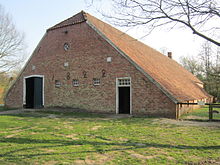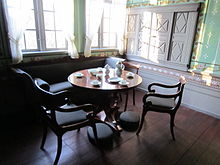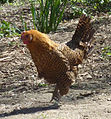Museum village of Cloppenburg
 Wehlburg court complex in the museum village of Cloppenburg |
|
| Data | |
|---|---|
| place | Cloppenburg |
| Art |
open air museum
|
| Website | |
| ISIL | DE-MUS-032215 |
The Museumsdorf Cloppenburg - Lower Saxony open-air museum in the Lower Saxony district town of Cloppenburg is one of the oldest open-air museums in Germany. The main task of the museum is to research the rural monuments and everyday culture of the federal state of Lower Saxony and to document them true to the original using examples.
The Lower Saxony Open Air Museum is a non-profit organization . The museum village of Cloppenburg has more visitors than any other museum in Lower Saxony (around 250,000 per year).
history
The museum village was built in the early 1930s on the initiative of Heinrich Ottenjann , a Cloppenburg student who also became the first museum director. The facility was officially opened on Ascension Day 1936 and continued to grow in the years that followed. On April 13, 1945, six houses in the museum village were destroyed by artillery fire, including the Quatmannshof. The farm was reconstructed down to the last detail until 1962. Heinrich Ottenjann's successor as museum director was his son Helmut Ottenjann in 1961 . From 1996 to 2018 Uwe Meiners was director of the open-air museum. Julia Schulte to Bühne has been running the museum since 2018 .
task
The Lower Saxony Open-Air Museum functions today as an educational and research facility for the cultural and agricultural history of Lower Saxony. Specifically, it has "the task of researching the rural architectural monuments of the federal state of Lower Saxony and documenting them realistically in the most important examples [...], at the same time the most diverse types of old handicrafts in rural areas are to be collected, researched and demonstrated. “The museum educational offers should be action and product-oriented.
The museum village also conducts its own research in order to be able to properly exhibit houses, furniture, devices and other objects of everyday life. Subjects involved are folklore, regional history and house research. A team of three scientists, supported by volunteers and project partners, designs exhibitions and accompanies the construction of new houses. This work is documented in scientific publications, which the museum village publishes for the most part in its own series. The scientific staff is supported by craftsmen who maintain numerous houses and demonstrate traditional working methods to visitors.
deals



The Lower Saxony Open Air Museum shows the history of rural Lower Saxony from the 16th century to the present on an area of approx. 20 hectares. In almost 60 historical buildings with the associated rural gardens and on other agricultural areas, the change in the relationship between man and the environment is discussed.
Initially, the form of reconstruction was chosen, which showed the houses as prototypes in their original state of construction. The main building types of the Low German hall house and the East Frisian Gulf house are presented in this way. Since the 1970s, houses have been restored while preserving the traces of their history and with references to the biographies of their residents.
In addition to buildings used for agriculture and handicrafts and houses for farm workers, there is also a half-timbered church from Klein-Escherde (built in 1698) and a peasant school from Renslage (built in 1751) on the grounds of the museum village of Cloppenburg .
Outside the actual museum village area, in front of the exhibition hall north of Höltinghauser Strasse, among other things, the large “ Oldenburg ” plow is set up.
Agriculture and crafts - residential and commercial buildings
The many rural buildings are mostly arranged in courtyards. In particular, the Hof Quatmann (from Elsten , built 1805) and the Hof Wehlburg (from Wehdel , built 1750), but also Hof Hoffmann (from Goldenstedt , built 1835/1840). These houses are Low German hall houses. Gulf houses are Hof Awick (from Scharrel , built in 1822) and Haus Meyer (from Firrel , built around 1900). The youngest building was the residential building of a wheelwright from Westerstede in 2011 (with components from 1566).
In the museum is situated next to farmers, Heuer and farm workers houses numerous examples of rural crafts, as it was practiced until well into the 20th century: wood turning , pewter , hoof and car manufacturer , coppersmiths , Lederschuhmacherei , clog making , carpentry , carpenter shop , Brewery , cooperage , blue dyeing , saddlery , pottery , gold and silversmiths as well as technical cultural monuments such as mills and power machines. A large part of the traditional handicraft in rural areas is thus documented.
Mills
The museum village has been a station on Lower Saxony's Mühlenstrasse since 2008 . It offers travelers on this holiday route :
- a post mill from Essern ( Nienburg district ), also called a post mill, probably built around 1638
- a cap windmill from Bokel (Cloppenburg district) from 1764, a gallery Dutchman, also known as an octagonal windmill or "Dutchman" for short
- a threshing block
- a coker windmill from Edewecht ( Ammerland district ) from 1879, originally designed as a water scoop mill
- a horse mill from Mimmelage ( district of Osnabrück ); a wooden mill, also known as a horse peg, for grinding the grain, built around 1850 to 1890. Grain was ground with the help of horses. The horse mill from 1868 in the threshing and grain barn of Hof Wehlburg is the last remaining horse mill in Lower Saxony.
Collections and exhibitions

Only a part of the collections of the museum village can be seen in the houses on the site. A large part of the furniture, tools, wagons, textiles, pewter objects and archival materials, on the other hand, are stored in the depots and presented to the public using selected examples in changing special exhibitions in Arkenstede Castle , the exhibition hall by the parking lot and the Münchhaus barn . Long-term exhibitions on agriculture and technology, historical furniture and the nobility in northwest Germany can be seen.
In addition to the winter months, traditional domestic animal breeds such as the Bentheimer Landschwein and the Westphalian Totleger are presented on the site.
Events
Since 2002, every year between Ascension Day and the Sunday before Pentecost, a " garden party " has taken place on the grounds of the museum village of Cloppenburg.
In 2011, a "historic village fair " and a St. Nicholas market were set up for the first time in the museum village of Cloppenburg .
Historical village fair on the Brink
Foundation of the museum in the time of National Socialism
The establishment of the museum during the National Socialist era (1934) raises the question of whether it was made against the background of National Socialist blood and soil mythology. Sabine J. S. Bardenhofer-Paul stated succinctly in her diploma thesis in 2009 without giving any further reasons: “The museum village of Cloppenburg in Lower Saxony, which was opened in 1936 under the direction of Heinrich Ottenjann, is considered the first large German open-air museum. It is evident that this was done with the help of the National Socialist government and that it served its ideological purposes. "
The founding of the museum village of Cloppenburg is to be seen in particular in the context of the history of the homeland movement: This came about as early as 1880 as a reflection of the urbanization of Germany and the interest of many townspeople in a memory of their rural roots. From this movement were out in the country Oldenburg already the 1910 Ammerland farmhouse in Bad Zwischenahn and 1912 the flue Kate in Neuchatel emerged as sensually tangible memorials. A local history museum was founded in Cloppenburg itself in 1922 .
Heinrich Ottenjann developed the concept of the Cloppenburg Museum Village before 1933, which he was able to implement in 1934. At the same time, Ottenjann was inspired by the holistic concept of the Scandinavian open-air museums , which tried to depict the history of the rural population documented in objects in its functional context.
The National Socialists advocated the idea of promoting homeland care and instrumentalized and ideologized the folkloric and agricultural-historical system that was emerging. Under the patronage of Gauleiter Carl Röver , the museum village was to become a collection of typical farmhouses from the Oldenburger Münsterland, which, as it were, as a “built construction guide” the “right sense and right attitude” for the craft and the ideology of a “new, healthy peasantry “Should convey. Nevertheless, the Museumsdorf Cloppenburg never became a Nazi cult site in the same way as the Stedingsehre open-air theater project in Bookholzberg , which was also supported by Röver , and there were also opponents of the Museumsdorf project in circles of the NSDAP .
Today there are regular events in the museum village that are supposed to provide information about Nazi demons. The employees of the museum village itself be enlightened act: For example, they comment on the thesis that the horses' heads on the Lower Saxon farmhouses ( Hall houses ) were originally remains of horses victims have been, the fact that this was a common by the Nazis myth that critical scientific review was not holding.
See also
literature
- Heinrich Ottenjann: The museum village in Cloppenburg and the idea of the open-air museum in Germany . In: Home calendar for the Oldenburger Münsterland . Vol. 7. 1958. pp. 76-80 ( online )
- Hermann Kaiser, Helmut Ottenjann: Museum Village Cloppenburg - Lower Saxony Open Air Museum , self-published, Cloppenburg 1985
- Hermann Kaiser, Helmut Ottenjann: Museum guide Museumsdorf Cloppenburg - Lower Saxony open-air museum . Museumsdorf Cloppenburg Foundation 1995, ISBN 3-923675-14-3 .
- Hermann Kaiser: A house and a family in difficult times: The reconstruction of the Wübbe M. Meyer farm complex from Firrel, East Friesland in the museum village of Cloppenburg . Museumsdorf Cloppenburg Foundation 2003, ISBN 3-923675-92-5 .
Web links
- official homepage
- Uwe Meiners: Ambitions defended against Nazis. Anniversary 125th birthday of Heinrich Ottenjann - father of the museum village . Northwest Newspaper . February 19, 2011
- Central for teaching media on the Internet (to): Cloppenburg Open Air Museum
- Holger Höge: Research report on the evaluation of the museum village Cloppenburg / Lower Saxony open-air museum in Cloppenburg. Psychological studies on user behavior in the Lower Saxony open-air museum in Cloppenburg (phenomenological inspection report, sociodemography, quantitative survey) . Oldenburg. 2002. 218 pp.
- The new boss of the Museumsdorf Cloppenburg on April 5, 2018 on ndr.de
- Are there looted Nazi property in the museum village of Cloppenburg? on November 26, 2018 on ndr.de
Individual evidence
- ^ Heinrich Kaiser: 250,000 guests in the museum . " Oldenburgische Volkszeitung" . December 30, 2009. p. 14
- ^ Hubert Gelhaus : The political-social milieu in Südoldenburg from 1803 to 1936 . Dissertation 1999/2001, p. 1630
- ↑ Hermann Kaiser: History of the Lower Saxony Open Air Museum Museumsdorf Cloppenburg ( Memento from July 19, 2011 in the Internet Archive ) (PDF file; 40 kB)
- ↑ a b Lower Saxony education server: FÖJ-Einsatzstellenliste 2004/2005 , p. 113 ( Memento of July 7, 2004 in the Internet Archive )
- ↑ List of publications of the museum village ( Memento from February 9, 2019 in the Internet Archive )
- ^ Homepage of the museum village. Section room, planing, painting - the artisans of the museum
- ↑ A drawing of a threshing block can also be found on the website "Threshing and Cleaning" ( Memento from August 24, 2011 in the Internet Archive ). There this invention is assigned to the mill builder Andrew Meikle .
- ^ District of Cloppenburg: Press release of May 23, 2007 on the 14th German Milling Day ( Memento of March 3, 2012 in the Internet Archive )
- ↑ Homepage of the garden party
- ↑ Reiner Kramer: Museum makes hype about the hype . Northwest Newspaper . June 8, 2011
- ↑ Angelika Hauke: Nikolausmarkt: Romantic, but without any kitsch ( page no longer available , search in web archives ) Info: The link was automatically marked as defective. Please check the link according to the instructions and then remove this notice. . Münsterland daily newspaper . October 6, 2011
- ↑ Sabine J. S. Bardenhofer-Paul: "A museum where a gaunzes village is poured out!" The collector Josef Haubenwallner and his Mönchhof village museum (PDF file; 3.17 MB). University of Vienna, December 2009, p. 26.
- ↑ Search for security. Homeland movement in Oldenburg . Exhibition in the Museumsdorf Cloppenburg ( Memento from July 19, 2011 in the Internet Archive )
- ↑ Article “Heinrich Ottenjann” ( Memento from May 17, 2014 in the Internet Archive ) (PDF file; 3.50 MB). In: Hans Friedl u. a. (Ed.): Biographical manual for the history of the state of Oldenburg . Edited on behalf of the Oldenburg landscape. Isensee, Oldenburg 1992, ISBN 3-89442-135-5 , p. 545 ff.
- ^ Hubert Gellhaus: The political-social milieu in South Oldenburg from 1803 to 1936 . Dissertation 1999/2001, especially section 1.3.4: The political instrumentalization of the traditional home movement , pp. 1613–1635
- ^ Heinrich Stiewe: Hallenhaus, Heimatstil and swastika. Rural construction in the northwest between 1920 and 1950 . Report on the 20th meeting of the house and structure research group in Arnhem (Netherlands, April 4-6, 2008).
- ↑ Carola Lipp, Uwe Meiners, Waldemar Röhrbein, Ira Spieker (eds.): Folklore in Lower Saxony. Lectures at the conference from February 28 to March 2, 2001 in the museum village of Cloppenburg - Lower Saxony open-air museum , in particular the specialist lecture by Heidi Rosenbaum, Oliver Doetzer and Sigrid Anna Friedreich on the importance of biographical research in the social history of family and childhood - using the project as an example "Everyday life in children under National Socialism" .
- ↑ Kirsten Reinhardt: Why do the Lower Saxony people have horse heads on the roof? In: Der Tagesspiegel , March 27, 2006.
Coordinates: 52 ° 50 ′ 56 ″ N , 8 ° 3 ′ 4 ″ E














